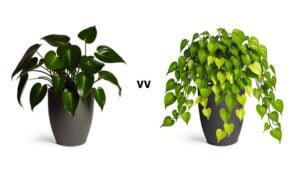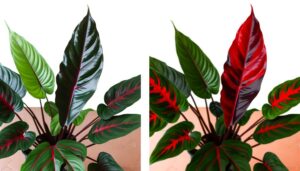Philodendron Cordatum Neon Vs Lemon Lime: Color Differences!
When distinguishing Philodendron Cordatum Neon from Lemon Lime, key differences lie in leaf coloration and texture. Neon features vibrant lime-green, smooth, and glossy leaves, while Lemon Lime displays a subdued yellow-green hue with a slight velvety texture.
Growth patterns also vary; Neon has denser foliage with shorter vines, whereas Lemon Lime grows more loosely with longer internodes. Both varieties thrive in bright, indirect light and require consistent moisture maintenance.
Pests and diseases common to both include aphids, spider mites, and fungal infections. For those interested in detailed growth conditions and best practices for each variety, continuing the discussion is recommended.
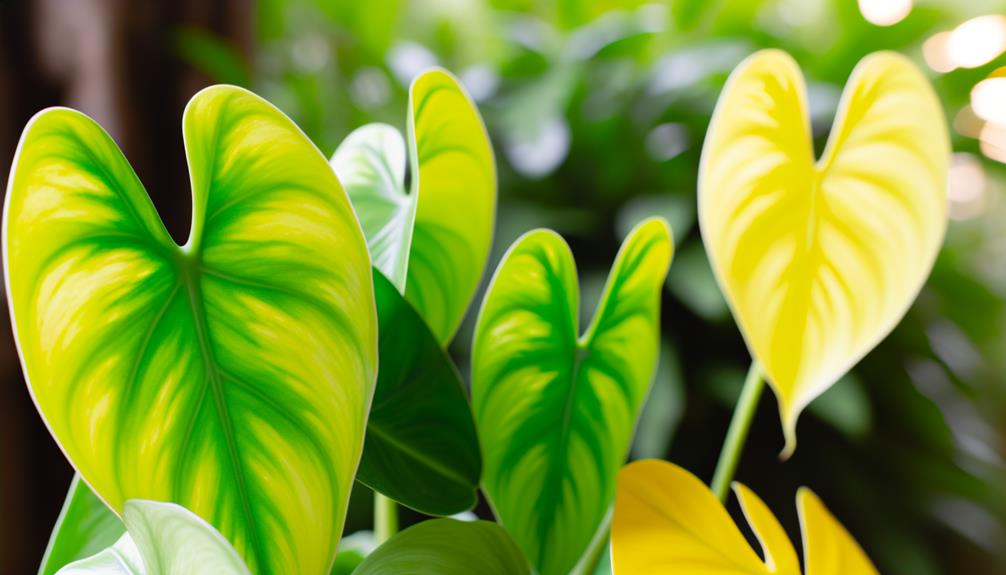
Comparison of Philodendron Cordatum Neon and Philodendron Lemon Lime
| Characteristic | Philodendron Cordatum Neon | Philodendron Lemon Lime |
|---|---|---|
| Leaf Color | Bright neon green | Lime green to yellow-green |
| Leaf Shape | Heart-shaped | Heart-shaped, more defined curve |
| Leaf Size | Generally smaller | Larger, average 5 inches long |
| Leaf Texture | Smooth, slightly leathery | Smooth, slightly leathery |
| New Leaf Color | Very light yellow-green | Slightly pink tint |
| Growth Habit | Vining | Vining |
| Light Preference | Bright indirect light | Bright indirect light |
| Humidity Tolerance | Prefers higher humidity | More tolerant of low humidity |
| Care Difficulty | Easy to moderate | Easy |
| Propagation | Easy to propagate from cuttings | Easy to propagate from cuttings |
Overview of Philodendron Cordatum Varieties

The Philodendron Cordatum varieties, including Neon and Lemon Lime, are distinguished by their unique leaf coloration and growth habits, making them popular choices among horticulturists and indoor plant enthusiasts. These varieties belong to the Araceae family and are native to tropical regions, known for their heart-shaped leaves and climbing or trailing growth patterns.
Neon and Lemon Lime are particularly noted for their vibrant hues, which result from differing chlorophyll concentrations and light reflection. Their adaptability to various indoor environments, coupled with moderate care requirements such as indirect light and consistent moisture, make them ideal for enhancing indoor green spaces.
Additionally, their air-purifying properties add functional value, making them not only aesthetically pleasing but also beneficial to indoor air quality.
Visual Differences
When comparing Philodendron Cordatum Neon and Lemon Lime, one can observe distinct differences in leaf coloration and texture. Although both varieties exhibit heart-shaped leaves, their visual characteristics set them apart.
The Neon variety has a bright, almost fluorescent green hue, creating a striking visual appeal. In contrast, the Lemon Lime variety displays a more subdued, yellow-green tone that gives it a softer appearance.
Key visual distinctions include:
- Leaf Color: Neon features a vivid green, while Lemon Lime presents a yellow-green.
- Leaf Texture: Neon typically has a smoother texture compared to the slightly rougher Lemon Lime.
- Growth Pattern: Neon tends to grow more compactly, whereas Lemon Lime displays a looser growth habit.
- Vein Prominence: Veins in Neon leaves are less pronounced than in Lemon Lime.
Leaf Color and Texture
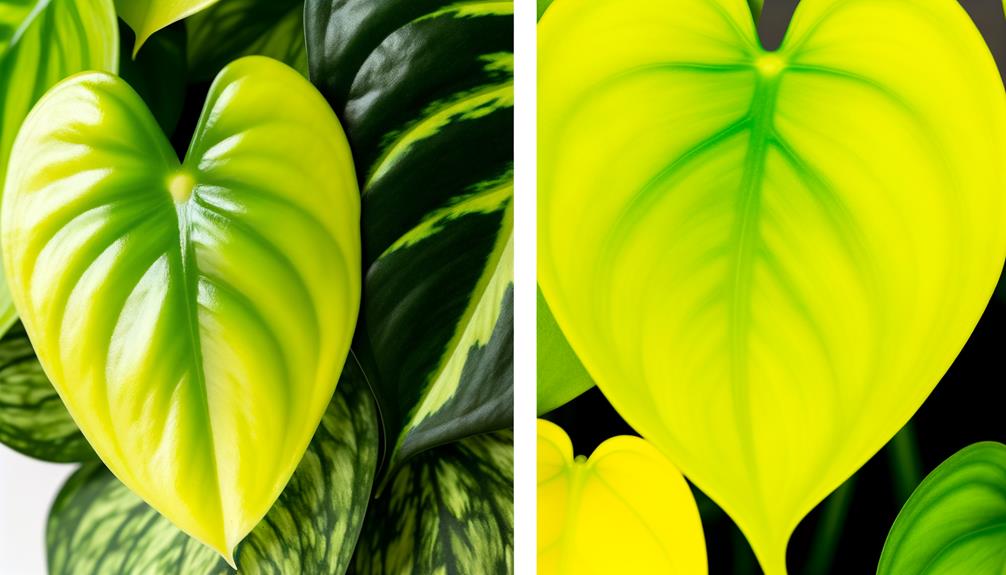
Examining the leaf color and texture of Philodendron Cordatum Neon and Lemon Lime reveals significant botanical distinctions that contribute to their unique aesthetic and horticultural characteristics.
Philodendron Cordatum Neon is characterized by its vibrant, lime-green foliage, which shifts to a bright chartreuse under ideal light conditions.
In contrast, Lemon Lime’s leaves exhibit a more subdued, yellow-green hue, often with a gradient effect that highlights its variegated patterns.
Texture-wise, Cordatum Neon leaves are smooth and glossy, providing a sleek visual appeal.
On the other hand, Lemon Lime’s leaves are slightly more matte and exhibit a subtle, velvety texture that enhances their tactile dimension.
These differences not only affect visual perception but also influence their care and environmental requirements.
Growth Patterns
Distinct differences in growth patterns between Philodendron Cordatum Neon and Lemon Lime can be observed, particularly in their vine length, leaf spacing, and overall branching tendencies.
The Cordatum Neon tends to exhibit more compact growth with shorter internodes, creating a denser appearance. Conversely, the Lemon Lime typically has longer vines with wider leaf spacing, contributing to a more sprawling habit.
Additionally, branching in Cordatum Neon is more frequent, leading to a bushier structure. In contrast, Lemon Lime often displays less frequent branching, resulting in a more linear growth form.
- Vine Length: Cordatum Neon has shorter vines compared to Lemon Lime.
- Leaf Spacing: Tighter in Cordatum Neon, wider in Lemon Lime.
- Branching Frequency: Higher in Cordatum Neon.
- Overall Appearance: Denser in Cordatum Neon, more sprawling in Lemon Lime.
Light Requirements
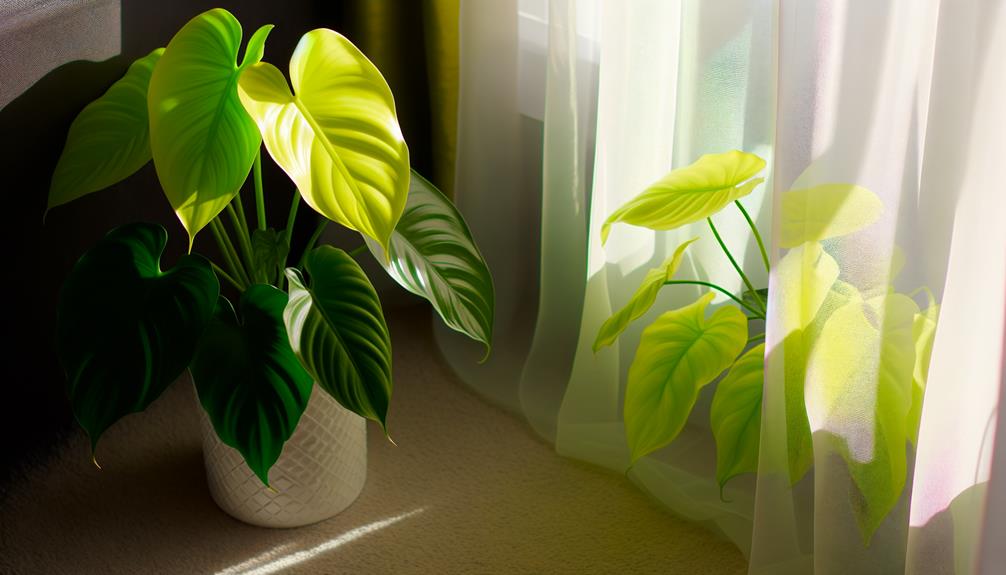
Understanding the light requirements for Philodendron Cordatum Neon and Lemon Lime is crucial for maximizing their growth and promoting their vibrant foliage. Both cultivars thrive in bright, indirect light, which mimics their natural understory habitat.
Direct sunlight should be avoided, as it can cause leaf scorching and chlorosis. For ideal photosynthetic efficiency, maintaining a light intensity of around 10,000 to 20,000 lux is recommended.
Additionally, these plants can tolerate lower light conditions, although this may result in slower growth and less vivid coloration. Using grow lights with a full spectrum, especially during shorter daylight periods, can help maintain consistent light exposure.
Ambient light should be evenly distributed to prevent etiolation and promote uniform leaf development.
Watering Needs
Best watering techniques for Philodendron Cordatum Neon and Lemon Lime are crucial to prevent root rot and maximize growth. Both species display similar watering needs, requiring a balanced approach to moisture. Consistency is key, as both under-watering and over-watering can be harmful.
Key watering guidelines include:
- Frequency: Water when the top inch of soil feels dry to the touch.
- Volume: Ensure thorough watering until water drains from the bottom, preventing salt buildup.
- Humidity: Maintain a relative humidity level between 40-60% for best growth.
- Water Quality: Utilize distilled or rainwater to avoid mineral accumulation from tap water.
Following these practices will support healthy root development and robust foliage, ensuring the plants thrive in their environment.
Soil Preferences
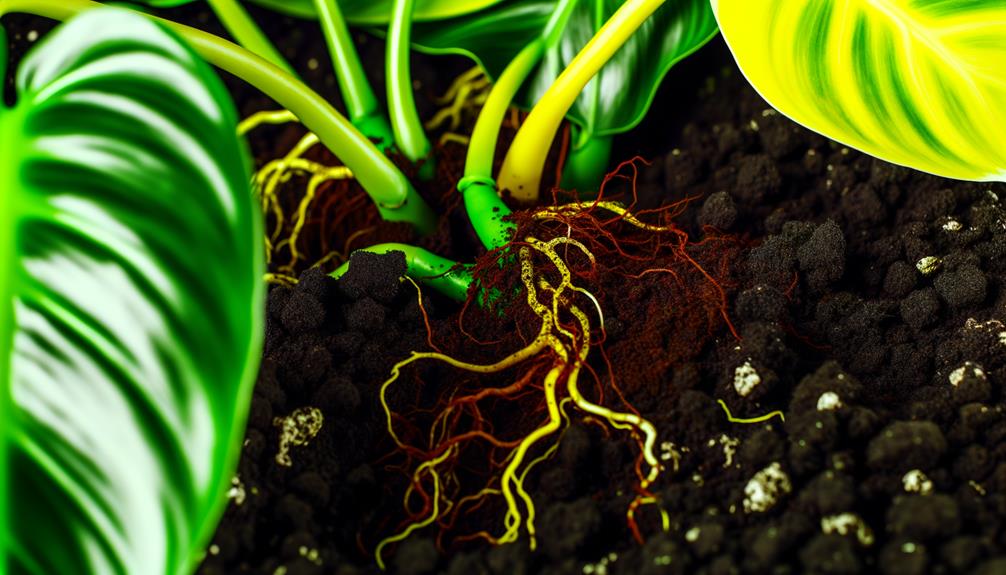
In conjunction with their specific watering needs, Philodendron Cordatum Neon and Lemon Lime require a well-draining soil mix that retains sufficient moisture without becoming waterlogged.
A balanced mixture often includes components such as peat moss, perlite, and orchid bark. Peat moss provides organic matter and moisture retention, while perlite enhances aeration and drainage. Orchid bark contributes to the soil’s structure, preventing compaction and promoting root health.
The ideal pH level for these philodendrons ranges between 5.5 and 6.5, ensuring best nutrient absorption. Regular monitoring of soil conditions is essential, as overly dense or compacted soil can lead to root rot.
Employing a high-quality, airy substrate facilitates robust growth and minimizes potential root-related issues.
Temperature and Humidity
When comparing the Philodendron Cordatum Neon and Lemon Lime, their temperature and humidity requirements are essential for best growth. Both varieties thrive in a temperature range of 65-80°F, yet exhibit subtle differences in their humidity preferences, with the Cordatum Neon favoring slightly higher humidity levels.
Seasonal adjustments are important, as both plants benefit from stable conditions to mitigate stress and promote consistent development.
Ideal Temperature Range
Philodendron Cordatum Neon and Lemon Lime thrive within a temperature range of 65-80°F (18-27°C) and benefit from humidity levels between 60% and 80%. Maintaining this specific temperature range is important for best growth and overall plant health. Deviations might cause stress, leading to suboptimal physiological responses.
Key aspects of the ideal temperature range include:
- Consistent temperatures: Sudden fluctuations can affect cellular processes and metabolic functions.
- Ambient warmth: Ensures proper enzymatic activity and nutrient uptake.
- Avoiding extremes: Temperatures above 85°F (29°C) or below 55°F (13°C) can cause damage.
- Night-time drops: Slightly cooler night temperatures (around 60°F or 16¼) mimic natural conditions, promoting robust growth.
Precision in temperature management is important for these tropical plants.
Humidity Preferences
Ensuring ideal moisture levels between 60% and 80% is crucial for the physiological well-being and growth of Philodendron Cordatum Neon and Lemon Lime. Elevated moisture facilitates prime stomatal function, enhancing transpiration and nutrient absorption.
Both cultivars exhibit robust growth under these conditions, as moisture mitigates stress-related symptoms such as leaf browning and curling. Insufficient moisture can lead to decreased cellular turgor pressure, adversely affecting photosynthetic efficiency and overall plant vitality.
Conversely, excessive moisture may predispose plants to fungal infections. Monitoring and maintaining appropriate moisture through hygrometers and humidifiers is recommended for indoor cultivation.
Additionally, grouping plants or placing them on moisture trays can create a microenvironment conducive to their specific moisture needs, ensuring sustained growth and health.
Seasonal Adjustments
Adapting to seasonal changes in temperature and humidity is crucial for maximizing the growth conditions of Philodendron Cordatum Neon and Lemon Lime. Both varieties thrive in stable environments, requiring specific modifications throughout the year to maintain their health and vigor.
Key considerations include:
- Temperature Management: Ideal range is 65-80°F (18-27°C). Avoid sudden temperature drops, especially below 55°F (13°C).
- Humidity Levels: Maintain relative humidity between 40-60%. Use a humidifier during dry winter months.
- Watering Adjustments: Reduce watering frequency in winter; ensure soil is moist but not waterlogged.
- Light Exposure: Provide bright, indirect light year-round. Adjust light levels to compensate for shorter winter days.
These adjustments promote growth and prevent stress-related issues.
Common Pests and Diseases
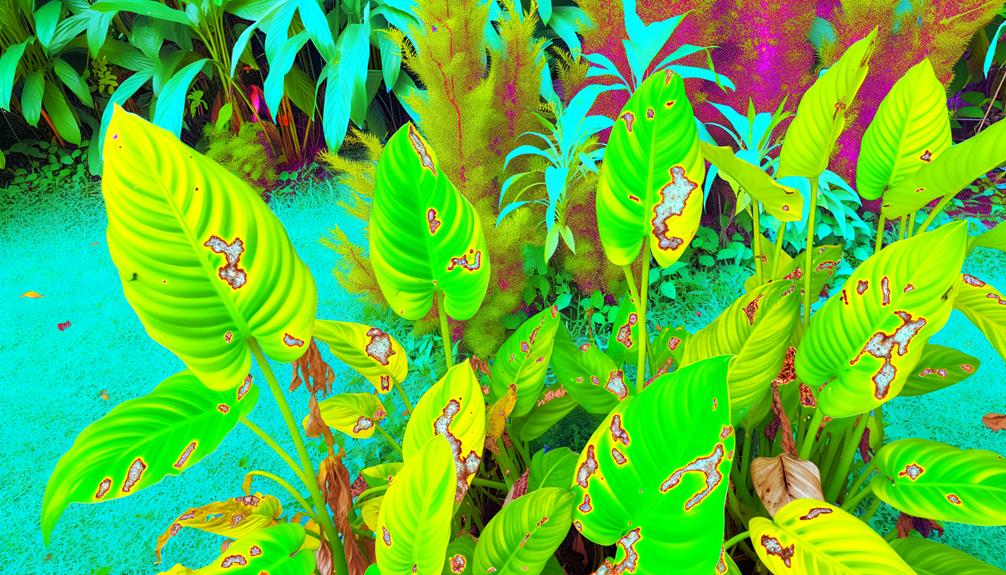
A thorough understanding of the common pests and diseases that affect Philodendron Cordatum Neon and Lemon Lime is essential for effective plant management and health maintenance.
Aphids, spider mites, and mealybugs are prevalent pests, often causing leaf yellowing, stunted growth, and reduced vigor. Regular inspection and the use of insecticidal soap can mitigate these issues.
Fungal infections, such as root rot and leaf spot, pose significant threats, often exacerbated by overwatering and poor drainage. Maintaining ideal soil moisture and ensuring adequate air circulation are critical preventative measures.
Bacterial blight, identified by water-soaked lesions, can be controlled through sterilized tools and prompt removal of affected foliage. Vigilance and proactive care are paramount to preserving plant health and essentiality.
Propagation Methods
Propagation methods for Philodendron Cordatum Neon and Lemon Lime primarily involve stem cutting techniques and rooting in water.
Stem cutting involves selecting a healthy section of the plant, making precise cuts below a node, and ensuring the presence of at least one or two leaves.
Rooting in water necessitates submerging the cuttings in water, maintaining consistent water quality, and monitoring root development before transplantation into soil.
Stem Cutting Techniques
To successfully propagate Philodendron Cordatum Neon and Lemon Lime, one must employ careful stem cutting techniques that guarantee the health and viability of the cuttings. Precision and care are essential in this process.
Key steps include:
- Selecting Healthy Stems: Confirm the mother plant is disease-free and choose robust stems with at least one node and a few leaves.
- Sterilizing Tools: Use sterilized, sharp scissors or pruning shears to make clean cuts, minimizing potential pathogen entry.
- Cutting Below a Node: Make the cut just below a node, which is vital for root development.
- Handling Cuttings Carefully: Avoid bruising by gently handling the cuttings and place them in a clean, moist environment immediately.
These steps ensure ideal conditions for successful propagation.
Rooting in Water
Regularly, starting Philodendron Cordatum Neon and Lemon Lime cuttings in water is a preferred method due to its simplicity and effectiveness in monitoring root development.
This method involves immersing the lower nodes of the cuttings in distilled or filtered water, making sure that at least one node is below the waterline to encourage root formation.
It’s crucial to change the water every few days to prevent microbial growth and maintain oxygen levels.
Monitoring root progress is made easier by the transparency of the container, allowing prompt detection of root initiation and any potential issues such as rot.
Once roots reach a length of approximately 2-3 inches, the cuttings can be shifted to soil, ensuring a smooth adjustment to their new growth medium.
Choosing the Right Plant for Your Space
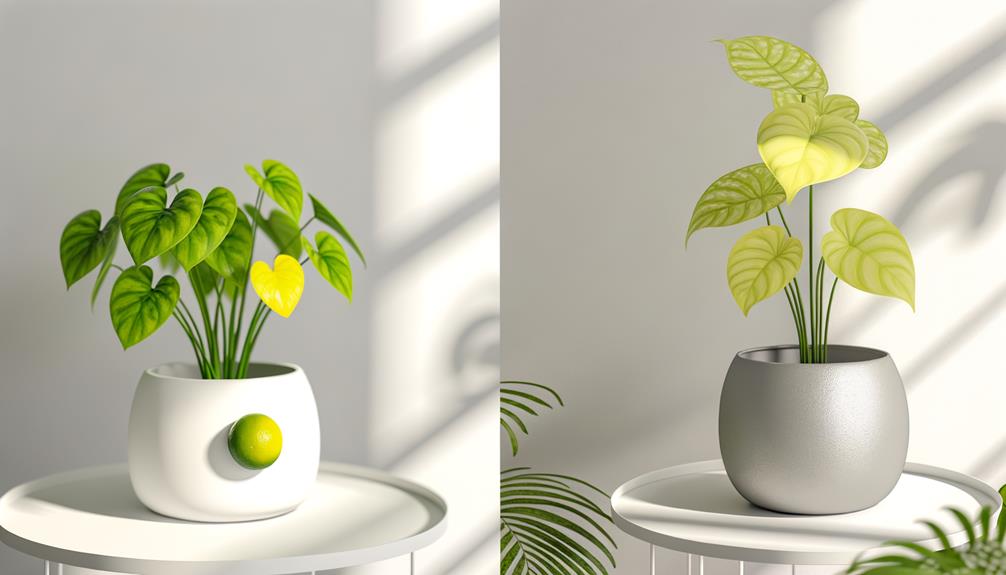
Selecting the appropriate Philodendron Cordatum variety—Neon or Lemon Lime—for your space requires a thorough understanding of their distinct light, humidity, and care requirements. The Neon variety thrives in bright, indirect light and prefers higher humidity levels, making it ideal for bathrooms or kitchens.
Conversely, the Lemon Lime variety is more adaptable to lower light conditions and standard household humidity, suiting living rooms and offices better.
Consider the following factors when making your decision:
- Light Requirements: Neon needs bright, indirect light; Lemon Lime tolerates lower light.
- Humidity Levels: Neon prefers higher humidity; Lemon Lime adapts to standard humidity.
- Growth Patterns: Both varieties have similar vining habits and require regular pruning.
- Maintenance Needs: Both are low-maintenance but benefit from occasional misting and fertilizing.
Conclusion
To sum up, both the Philodendron Cordatum Neon and Lemon Lime showcase unique visual and growth traits, making them exceptional additions to any collection.
The subtle variations in leaf color, texture, and growth patterns require thoughtful evaluation when choosing the right variety.
Which plant will flourish most in particular environmental conditions of light, temperature, and humidity?
Comprehending these factors, along with successful propagation techniques and pest control, guarantees the best possible health and aesthetic charm of either Philodendron type.



